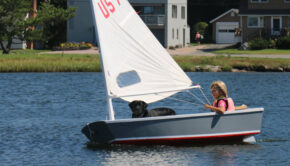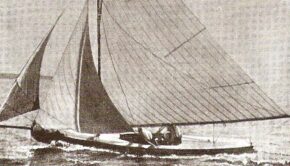Man v. Machine: Are the Supermaxis fair?
Published on March 1st, 2017
In the March 2017 issue of Afloat Magazine, David Salter makes the case for a review of the offshore race rules.
We hear the same complaint from rank-and-file offshore skippers after the Sydney-Hobart Race every year. If the television coverage and newspapers were any guide (they say), then the annual dash South was a contest between four 100-foot supermaxis. Everyone else was just making up the numbers.
That impression was amplified when, a few days after the race, Rolex took out prominent display advertising to congratulate Perpetual Loyal on being “the winners” – and made no mention whatsoever of the actual IRC handicap winner.
But it’s misleading to lump all the blame for this false emphasis on the television producers or newspaper editors. In any sporting contest the fight for the lead is where major attention naturally falls, and the media will always tend to follow what they believe to be popular interest.
And perhaps ’twas ever thus. In the 1950s, while the Livingston brothers chased line honours in Kurrewa IV, the Halvorsens had their sights set on the handicap prize with Solveig and Anitra.
But the intense concentration on the supermaxi drag race to the virtual exclusion of all other competitors is a relatively new development. These days even a keen follower of offshore racing struggles to remember who was really the overall winner of the Sydney-Hobart – but everyone knows about Comanche, Wild Oats and Loyal.
I would have no issue with this situation if all yachts in the fleet were competing on genuinely equal terms, but they aren’t.
Indeed, to my mind, the supermaxis (and their shorter imitations) should not be accepted as entries in the race as we know it. They are certainly very exciting boats, but they should be racing against each other – like with like – and not against the smaller conventional yachts over whom they hold immense advantages.
This is, of course, a highly provocative suggestion that won’t be welcomed by the Cruising Yacht Club of Australia, Rolex or the owners and sponsors of the more prominent line-honours contenders. But I believe it’s an argument that at least deserves a serious hearing.
The core problem is the changes to our rules that allowed the use of stored power and moveable ballast. Anyone outside the world of yachting is astonished to learn that the big boats they so admire have to keep an engine running all the way to Hobart to deliver power to their winches, cant the keel and move water ballast around the boat.
To me, the sport of ocean racing is a unique test of skill, strength, stamina and tactics. It should not be a contest between people pushing buttons.
Technology has its place. Improvements in hull design, rigs, sails and electronics are all welcome but they should not supplant or subvert the basic physical elements of fair competition.
If a boat cannot be properly sailed using muscle power alone then it is (at least in my contention) actually a motor-sailer and should not be competing against conventional yachts.
“Oh, that horse has long since bolted,” say the pragmatists. “Get with the program. They changed the rules more than a decade ago, so everyone should just accept it.”
In one sense that is undeniable. Stored power and moveable ballast are here to stay, or at least until they are superseded by some new technology that delivers even greater power-to-weight benefits. The authorities that govern ocean racing and stage the major events are not about to return to their old rules.
But if they are so keen to embrace almost anything that increases speed, why does the Sydney-Hobart still refuse to accept multihull entrants? The big tris have proven their safety if sailed properly, and they offer by far the most spectacular offshore sailing on the planet.
Meanwhile, consider this: Wild Oats XI pulled out of the last Sydney-Hobart after a simple mechanical failure in its canting keel mechanism. The implicit admission behind that retirement was that even with its keel locked in an upright position (and in a moderate wind aft of the beam) the maxi would not have been competitive, so they threw in the towel.
That decision also underlined the reality that the supermaxis cannot be sailed safely – or effectively – with human energy alone.
There are other aspects of this mismatch that make the contest even more unfair.
Engines never flag from exhaustion, get seasick, injured, or need sleep. They can run at peak efficiency 24 hours a day. The use of this limitless power-on-demand means that crews on the supermaxis don’t get as tired as their comrades on human-powered yachts.
That is a significant advantage that cannot be sensibly counterbalanced by handicapping. TCFs can only apply fairly across a fleet if all the boats are of a generic type, and are sailed using the same general principles.
Next, canting keels and/or moveable water ballast – made possible by that ever-running engine – mean the supermaxis can carry proportionately more sail area at any given wind speed than fixed-keel yachts, and sail with less bulb mass. Again, those are huge advantages.
At the same time, stored on-board power can exert forces well beyond human capacity. Hydraulic or electric winches grind in their huge jibs, bring the traveller up the track, haul halyards, and furl and unfurl headsails at incredible speeds. Pumps fill and empty water ballast tanks – all at the push of a button. 12-15 tonnes of load on the runners of a supermaxi is not uncommon. Try that by hand!
And a supercharged maxi will cover the course very quickly. Consequently, they enjoy the significant weight-saving benefit of needing to take less food and water, and the crew’s strength and concentration is required for a much shorter period.
The combined effect of all these advantages is extraordinary performance. As anyone who has raced against the 100-foot behemoths will confirm, after a few hours the sheer speed of the maxis means that the middle-of-the-fleet boats will often be racing in very different conditions.
Handicapping, which is predominantly based on the measurable physical metrics of the boats and their sails, struggles to even out these advantages. To my mind it is therefore unreasonable for a yacht using stored power to win the Hobart race on IRC, yet that is what happened in 2005, 2012 and 2016.
If you were to pit a weekend 12-handicap golfer against Tiger Woods on scratch, the two would still have to play their match with essentially the same clubs, same balls, on the same course, at the same time. The handicap would apply fairly.
Yet in the current supermaxi versus conventional yacht contests, the two classes are configured entirely differently, sailed differently, and are likely to be racing in different conditions. Is that fair?
And before you dismiss all this as no more than the bleatings of some sour old yacht club fuddy-duddy pining for the glory days, let me say that I have nothing against the supermaxis per se. They are awe-inspiring machines, and I’ve sailed on them enough times to understand their appeal, and how they work.
But I’ve also raced on conventional maxis – such as Apollo and Condor – where it took four strong men on the coffee-grinders just to trim the genoa (and everyone had to sit on the rail to help keep the boat upright). Sure, we were much quicker than an S&S 34, but the underlying design parameters, rating rules and demands on crew work were common to all entrants.
Defenders of the ‘speed is king/anything goes’ approach like to employ an analogy with Formula 1. Everyone benefits, they claim, when technology is allowed to develop competitively, and with minimal restrictions.
But that analogy is false. The technical rules in F1 are designed to bring the cars closer together in performance so that the racing is as fair as possible. This puts a premium on driving skill and tactics over engine power.
In offshore yachting it’s now the exact opposite. As they stand, our rules actually encourage and support the widening performance gap between a small, elite group of yachts and the remainder of the fleet.
What’s the solution? It seems we will never be able to stop the well-off owners employing the latest technology in their quests for trophy glory. But not all new technology is necessarily good for the sport as a whole. They don’t allow electric hub motors in the Tour de France.
When the Royal Ocean Racing Club was founded in 1924, Yachting Monthly magazine greeted the news by describing the sport as an ideal test of “skill, courage and endurance”. The man was more important than the machine.
In my view, yachts that employ stored power should be racing in their own separate division, under any handicapping system they agree amongst themselves, and for their own line honours trophy.
Author: David Salter is an independent journalist and offshore sailor who has competed in 10 Sydney-Hobart races. He is the author of Ragamuffin Man – The World of Syd Fischer.









 We’ll keep your information safe.
We’ll keep your information safe.